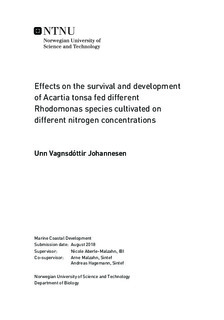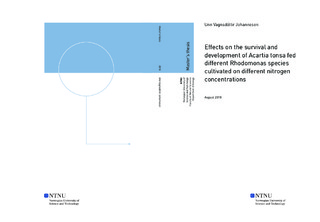| dc.description.abstract | Marine larvae need a live feed with a high amount of PUFA especially EPA and DHA to have a healthy development. Copepods are the preferred choice of live feed since they are there natural food source and have the right biochemical composition for a healthy larval development. The main question was to examine the possibility to increase the EPA and DHA content in A. tonsa through a mono-diet of R. baltica and R. salina cultivated on four different nitrogen concentrations 0, 33, 66, and 100% NaNO3. The experiment was divided in two the microalgae and the copepods. In the microalgae experiment was carried out by measuring the growth rate, carrying capacity, and biochemical composition (C:N molar ratio, TL, and FA) of R. baltica and S. salina reared on 0, 33, 66, and 100% NaNO3 in the growth medium. The NaNO3 treatment that had the highest DHA, EPA, and C:N ratio of each species was chosen to a feeding experiment of A. tonsa. R. baltica and R. salina cultivated in 66% NaNO3 had statistically higher (ANOVA, p <0.05) amounts of DHA and EPA in the stationary phase then the other treatments within each species. R. baltica and R. salina cultivated in 66% NaNO3 showed Furthermore, R. baltica 100% NaNO3 was also included in the feeding experiment. In the feeding experiment the three chosen treatments were fed as mono diets to A. tonsa where development, survival, C:N molar ratio, and the FA profile was studied for dietary effect at development stage NIV and CI (day 3 and 6). There appeared to be some slight variation in the DHA and EPA in the NIV stage however in the CI there was no difference in the FA % distribution in CI between the different treatments. The amounts of FA were overall slightly higher in the A. tonsa fed R. baltica 66% NaNO3 and had the highest survival 25.5% after 6 days. Therefore, from the data collected in this study feeding A. tonsa R. baltica 66% NaNO3 appears to be the sensible choice. Not can be definitively concluded since the were no statistical differences between any of the treatments in feeding experiment of A. tonsa. Moreover, the study showed R. baltica is superior to R. salina under the same cultivation conditions. | |

